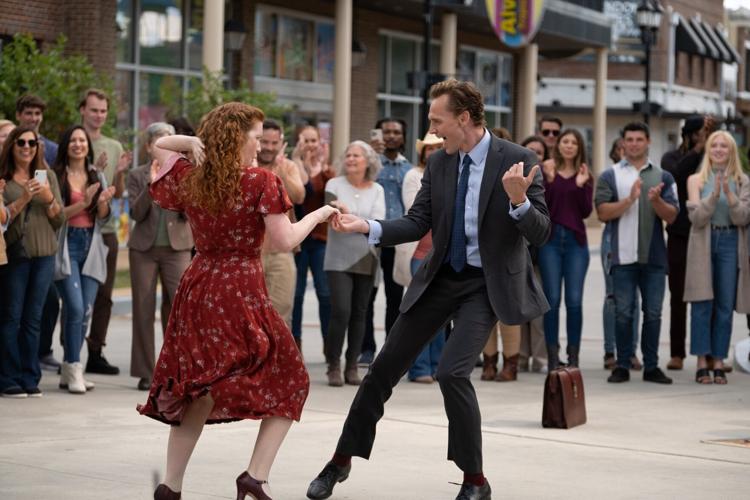Over the course of a week, actor Tom Hiddleston danced so much ŌĆ£I had burned holes in my shoes.ŌĆØ
Part of the stress was dancing on the hot asphalt in Alabama; part of it was making sure that dance was a key part of the film, ŌĆ£The Life of Chuck.ŌĆØ
Based on a Stephen King novella, the movie touches on those seminal moments that matter in life ŌĆö not the job promotions, the awards or the traditional benchmarks.
TheyŌĆÖre the ŌĆ£moments in our lives which will become the brightest stars in our memories in the last hours of our lives,ŌĆØ Hiddleston says. For his character, Chuck Krantz, one of those moments is an impromptu dance on a street. A drummer starts working out a beat, Chuck drops his briefcase and soon, the accountant is sharing moves with a woman who feels a similar vibe.

Tom Hiddleston plays an accountant who take a leap of faith and begins dancing in the streets of a town in "The Life of Chuck," a film based on a Stephen King novella.┬Ā
The dance is the centerpiece of Mike FlanaganŌĆÖs film ŌĆö a segment that took four days to capture. Choreographer Mandy Moore and her assistants worked with Hiddleston five or six weeks before filming. ŌĆ£We all kind of collected together in London, initially, then in Alabama for a week,ŌĆØ he says. ŌĆ£We were in a dance studio in Fairhope.ŌĆØ
People are also reading…
Among the segments: moonwalking. Flanagan tried to do it but couldnŌĆÖt. ŌĆ£ThereŌĆÖs a horrifying video of it out there somewhere,ŌĆØ he says.
For Hiddleston, it was an opportunity to check off all the dance experience a young Chuck might have had.
In another segment of the film, Benjamin Pajak (who plays a younger version of Chuck), is shown learning steps and discovering the joy of dance.
To make sure young Chuck and old Chuck matched, Moore united the two and offered signature moves that would be evident in both segments.
ŌĆ£I donŌĆÖt think I would have gotten through it if I didnŌĆÖt have Mandy,ŌĆØ Pajak says.
In those non-dancing moments, the young actor (who starred on Broadway as Winthrop in ŌĆ£The Music ManŌĆØ) brought a level of professionalism that ŌĆ£raised the bar for everybody,ŌĆØ co-star Kate Flanagan says. He brought a sense of wonder ŌĆ£that shows in everybodyŌĆÖs eyes when they look at you in the movie.ŌĆØ
Other standout moments leaned heavily on KingŌĆÖs thesis statement.

Mark Hamill plays a man who finds joy in numbers in "The Life of Chuck."┬Ā
Example: Mark Hamill, who plays ChuckŌĆÖs father, has a monologue that extols the joys of math.
ŌĆ£At one point, I was having a hard time making a jump from one line to the other,ŌĆØ he says. ŌĆ£One line was, ŌĆśJust think, you could go to dinner and figure out how much it cost for everybody to eat ŌĆ” and itŌĆÖs good for your brain.ŌĆÖ And IŌĆÖd say, ŌĆśHow do I make that jump?ŌĆÖ And then it hit me: Eat brain. So in the side I wrote, ŌĆśZombie.ŌĆÖ Anything to help me remember lines.ŌĆØ
When he saw the film, the line had been cut. ŌĆ£ThatŌĆÖs a different kind of apocalypse,ŌĆØ Mike Flanagan says.
In one of the three parts of the film (itŌĆÖs told in chapters), two characters consider the end of life.
ŌĆ£As things start to break down, as traffic grinds to a halt, as the Internet goes down, as the phone lines go down, as you see images of whole land masses sliding into the sea (you realize) I donŌĆÖt need this ŌĆ” I have two legs,ŌĆØ Hiddleston says. And the character who has that moment of enlightenment decides to walk to his friendŌĆÖs place and have a real conversation.
ŌĆ£Stephen is asking questions┬ĀŌĆö we have the resources we need but we lean our technologies, which are simulating real connection, but theyŌĆÖre not the substance of human connection,ŌĆØ Hiddleston explains.
ChuckŌĆÖs non-dance scenes take place in a bed where his life is coming to a close. As elements become stripped away, he revisits those important memories.
ŌĆ£I had this awareness of the preciousness and the fragility of living, but also the magic and majesty of connection in the every day,ŌĆØ Hiddleston says. ŌĆ£As itŌĆÖs so beautifully described in the story, this moment on the sidewalk on a Thursday afternoon is maybe an expression of the most intense freedom of his entire life.ŌĆØ

















